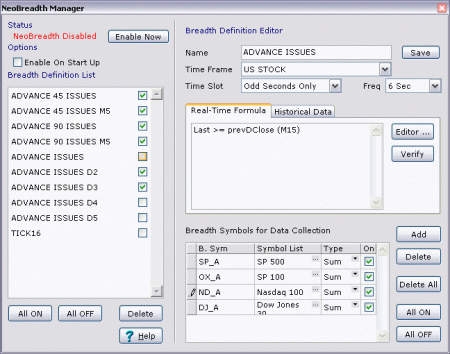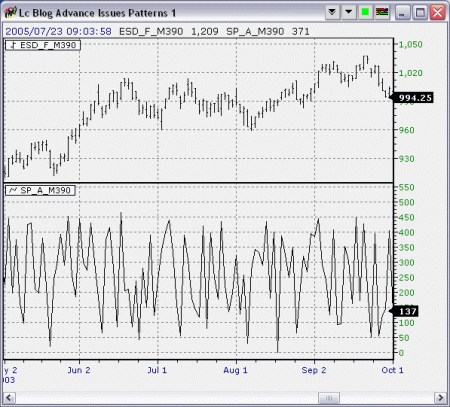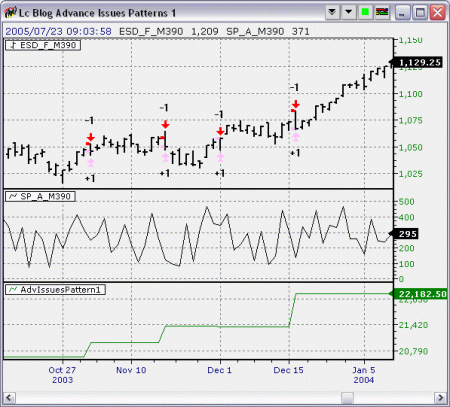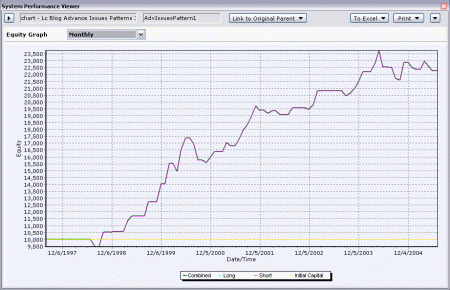Advance Issues Pattern 1
NeoBreadth enables our users to collect user defined breadth data within NeoTicker, both in real-time and in reconstruction of historical breadth data. The analysis of customized market breadth data is not a common topic in technical analysis as NeoTicker is the only platform that can do that properly. How useful are customized breadth data? How do we utilize these information?
I’ll present a simple trading system based on advance issues of S&P500 as our first example on how to tap into the power of complex breadth analysis.
What Is Advance Issues?
Advance Issues is the statistics on number of issues within a basket of symbols that has a higher close than the close of the previous trading day.
For example, the Advance Issues reported on TV in United States is the number of stocks that are closing equal to or higher than the previous trading day, based on the actively traded symbols in the New York Stock Exchange. The number of issues traded in NYSE is difference every day because some instruments are just not as active as the other ones. Thus, in order to make a proper comparison, NYSE also reports the Decline Issues statistics on the issues traded on the day.
Advance Issues, Decline Issues, and other measures of the broad market are called market breadth. They represent another dimension of measure on the market as a whole.
The advance issues on S&P 500 is a different type of breadth data. It does not really represent the whole market because the data is collected from the components of S&P 500 only. I call this customized breadth data because it focus on specific issues we’ve selected. In this case, we are interested in making trading decision on the emini S&P 500 index futures, thus we collect S&P 500 advance issues breadth data to assist us in the process of analysis.
There is a clear advantage of customized breadth data. Notice that we do not really care of the number of declining issues within S&P 500 because the basket is of fixed size which makes the number of declining issues almost always equal to subtracting the number of advance issues from 500.
Data Collection
To collect advance issues of S&P500, we need to define a NeoBreadth symbol SP_A within NeoTicker. The real-time formula is,
Last >= PrevDClose (M15)
We will need to associate the SP_A symbol with a symbol list.
Here is the screenshot on how to define Advance Issues for S&P500, S&P100, Nasdaq 100, and Dow Jones 30. The Advance Issues definition is predefined in NeoTicker, thus if you have NeoTicker, all you have to do is enable the real-time data collection.
During market hours, these breadth symbols will collect data in real-time and you can access them as if they are regular symbols. If you do not have streaming data over 500 symbols in real-time, you can still construct historical intraday and daily data of these breadth symbols in after market hours using the historical breadth data generator.
One thing you have to keep in mind is that breadth symbols require maintenance. Usually index like S&P 500 will have adjustments to its components every few weeks. You will have to update the symbol list associated with the NeoBreadth symbol so that statistics is collected for the correct basket. Missing a few symbols over a month or two does not matter that much, if you are concerned that the accuracy is affected with minor difference in the components.
Here is a daily chart of emini S&P and S&P 500 Advanec Issues,
At your first glance, you will probably think that the advance issues data is just a mess as you are not getting obvious eye catching patterns. Thats exactly the point. The data cannot be analyzed easily due to the volatile nature of advance issues within a small basket of stocks.
Identifying An Extreme
Here is a simple pattern based on the S&P 500 advance issues. It is a common sense pattern, that means it not generated from heavy data mining. It is just something that make sense.
If advance issues rises consecutively for 2 days and then turn back down a little, we can expect that it is likely the very next trading day we will experience some form of pullback.
Two important things we have to remember here.
First, the pattern I described does not involve the price at all. That means, any instrument that is highly correlated to the underlying index (in this case, the S&P 500), can be a potential candidate to trade the pattern with.
Second, it is a raw signal. That means, in this investigative state we are not going to add extra money management rules nor extra filtering to improve the signal. We just want to know if significant bias exists.
Our System
Since the signal is so simple, and the expectation is a general conjecture on next trading day behaviour, we can implement the system as a end-of-day daytrading system.
In NeoTicker’s formula, the system looks like this,
short_signal := data2 > average (data2, param1) and data2 (1) > data2 and data2 (2) < = data2 (1) and data2 (3) < data2 (2);
shortatmarket (short_signal, defaultordersize,"Short");
shortexitnextclose (true, defaultordersize, "SExit");
You can download the system here, Advance Issues Pattern 1. Use indicator manager to install the downloaded script.
This system needs two (2) data series. The primary one is the instrument we are going to trade on, and the second one is the advance issues data we've collected.
Since we wanted to see if the one day bias is significant, the system always exit on close on the same day.
I will use the emini S&P as the example instrument to trade on. We'll include basic comission, etc. into the system to make it more realistic.
Lets take a look at the system how it looks like in the chart,
And here is the equity curve of this system since 1999.
The performance is good and is very stable. It also leave a lot of room for other signals to be integrated into the system since it is not trading that often.
Summary
Customized breadth data has a lot to offer due to its nature as a price independent statistics. It does not have the many weaknesses of broad market breadth statistics. I am sure there will be more discoveries in utilizing this concept as it gets better recognition over time.
Advance issues is chosen as an example because its concepts are more familiar for most of you. I'll present a few more interesting trading signals based on various customized breadth data, so stay tune.
















